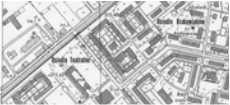|
Max Hirsh
The four key success factors for developing airport areas Urban Development Issues, vol. 68(2), 75–79. https://doi.org/10.51733/udi.2020.68.18
Keywords: airport urbanism, airport areas, urban development, regional development, non-aeronautical revenue
|
ABSTRACT
Developing the airport area is a priority for airports, and for the cities and nations that they serve. On the one hand, airports rely on landside real estate as a crucial source of non-aeronautical revenue, and as an insurance policy designed to mitigate risks inherent to the aviation industry. On the other hand, cities and regions promote airport-led urban development to achieve a broad range of social and economic development goals. Drawing on a global survey of more than 2,000 urban planners, policymakers, developers, and aviation professionals, the article identifies the four key drivers that fundamentally determine the success or failure of any airport area development project. Specifically, it highlights customer focus, site-specific development, effective governance, and project positioning as necessary preconditions for delivering a substantial return on investment and for moving efficiently from the concept stage to implementation.
Developing the airport area is a priority for airports, and for the cities and nations that they serve. On the one hand, airports rely on landside real estate as a crucial source of non-aeronautical revenue, and as an insurance policy designed to mitigate risks inherent to the aviation industry. On the other hand, cities and regions promote airport-led urban development to achieve a broad range of social and economic development goals. Drawing on a global survey of more than 2,000 urban planners, policymakers, developers, and aviation professionals, the article identifies the four key drivers that fundamentally determine the success or failure of any airport area development project. Specifically, it highlights customer focus, site-specific development, effective governance, and project positioning as necessary preconditions for delivering a substantial return on investment and for moving efficiently from the concept stage to implementation.
REFERENCES
Airports Council International (2019) Airports Economic Report, ACI, Montréal.
Appold, S. & Kasarda, J. (2013) The Airport City Phenomenon: Evidence from Large US Airports, Urban Studies, 50(6), 1239–1259. https://doi.org/10.1177/0042098012464401.
Gueller, M. & Gueller, M. (2002) From Airport to Airport City, Gustavo Gill, Barcelona.
Hirsh, M. (2016) Airport Urbanism: Infrastructure and Mobility in Asia, University of Minnesota Press, Minneapolis. https://doi.org/10.5749/minnesota/9780816696093.001.0001.
Hirsh, M., March 2017, What’s Wrong with the Aerotropolis Model?, Site Selection: The Magazine of Area Economic Development. Available from: https://siteselection.com/issues/2017/mar/airport-cities-whats-wrong-with-the-aerotropolis-model.cfm [accessed: 23.01.2021].
Hirsh, M. (2019) Developing Successful Airport Real Estate: An Airport Urbanism Approach, Journal of Airport Management, 13(2), 186–197.
Freestone, R. (2009) Planning, Sustainability, and Airport-Led Urban Development, International Planning Studies, 14(2), 161–176. https://doi.org/10.1080/13563470903021217.
Freestone, R. & Baker, D. (2011) Spatial Planning Models of Airport-Driven Urban Development, Journal of Planning Literature, 26(3), 263–279. https://doi.org/10.1177/0885412211401341.
Schaafsma, M., Amkreutz, J., & Güller, M. (2008) Airport and City: Airport Corridors as Drivers of Economic Development, Schiphol Real Estate, Schiphol.
Thierstein, A. & Conventz, S. (2018) Airports, Cities, and Regions, Routledge, London.
van Wijk, M., van Bueren, E., & te Brömmelstroet, M. (2014) Governing Structures for Airport Regions: Learning from the Rise and Fall of the ‘Bestuursforum’ in the Schiphol Airport Region, Transport Policy, 36, 139–150. https://doi.org/10.1016/j.tranpol.2014.08.006.
Airports Council International (2019) Airports Economic Report, ACI, Montréal.
Appold, S. & Kasarda, J. (2013) The Airport City Phenomenon: Evidence from Large US Airports, Urban Studies, 50(6), 1239–1259. https://doi.org/10.1177/0042098012464401.
Gueller, M. & Gueller, M. (2002) From Airport to Airport City, Gustavo Gill, Barcelona.
Hirsh, M. (2016) Airport Urbanism: Infrastructure and Mobility in Asia, University of Minnesota Press, Minneapolis. https://doi.org/10.5749/minnesota/9780816696093.001.0001.
Hirsh, M., March 2017, What’s Wrong with the Aerotropolis Model?, Site Selection: The Magazine of Area Economic Development. Available from: https://siteselection.com/issues/2017/mar/airport-cities-whats-wrong-with-the-aerotropolis-model.cfm [accessed: 23.01.2021].
Hirsh, M. (2019) Developing Successful Airport Real Estate: An Airport Urbanism Approach, Journal of Airport Management, 13(2), 186–197.
Freestone, R. (2009) Planning, Sustainability, and Airport-Led Urban Development, International Planning Studies, 14(2), 161–176. https://doi.org/10.1080/13563470903021217.
Freestone, R. & Baker, D. (2011) Spatial Planning Models of Airport-Driven Urban Development, Journal of Planning Literature, 26(3), 263–279. https://doi.org/10.1177/0885412211401341.
Schaafsma, M., Amkreutz, J., & Güller, M. (2008) Airport and City: Airport Corridors as Drivers of Economic Development, Schiphol Real Estate, Schiphol.
Thierstein, A. & Conventz, S. (2018) Airports, Cities, and Regions, Routledge, London.
van Wijk, M., van Bueren, E., & te Brömmelstroet, M. (2014) Governing Structures for Airport Regions: Learning from the Rise and Fall of the ‘Bestuursforum’ in the Schiphol Airport Region, Transport Policy, 36, 139–150. https://doi.org/10.1016/j.tranpol.2014.08.006.

